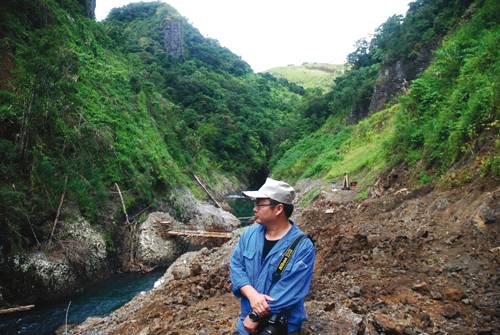Nadarivatu: a brief history
Nadarivatu was originally designed as a joint venture project between the FEA and an Australian company, Pacific Hydro Limited. Pacific Hydro pulled out in early 2007, reportedly as a result of low anticipated returns. The FEA continued to pursue the scheme on its own, together with in-principle financial support from the European Investment Bank. But this support was put on hold when it became clear that Frank Bainimarama, Fiji’s military dictator, would not be returning the country to democracy anytime soon.
Enter the Chinese government. The state-owned China Development Bank agreed to provide US$70 million for the Nadarivatu project in the form of a concessional loan, with the Fiji Electricity Authority providing US$50 million from a domestic bonds issue. The ANZ Bank is responsible for US$30 million. China Development Bank’s support was subject to one condition: the hydro scheme was to be constructed by a Chinese firm – Sinohydro Corporation Limited.
Some issues with the project
Sinohydro’s international labour record is poor. It has been accused of worker maltreatment and poor work quality standards in places as varied as Burma, Ecuador, and Oman. The company has been reprimanded by China’s State Assets and Supervision Administration Commission, and in 2006 was given a grade D (the lowest possible grade was E) by the same commission due to its continued violations of Chinese environmental and safety standards.
In Fiji, the Construction Energy and Timber Workers Union (CETWU), which represents local workers on the project, has protested about occupational health and safety violations. According to CETWU General Secretary John Paul, ‘local workers (have not been) provided with proper toilets and privacy, clean drinking water, safety boots, first aid kits, personal protective equipment, decent eating areas or changing facilities’ Paul has also alleged that Fijian workers have been deprived of ‘Fiji National Provident Fund contributions, wage slips, and overtime,’ and have been paid a half day’s pay for a full day’s work. Discussions with FEA personnel indicate that complaints directed to Sinohydro have been largely ignored.
In addition, Sinohydro’s use of Chinese labour and equipment will reduce the Nadarivatu’s benefits to the local economy. Approximately 300 Chinese workers are in Fiji to complete the project. Not all these workers are skilled, despite an agreement with the Fiji Government that only skilled workers would be brought in to construct the project. Indeed, observers note that many of these workers are involved in menial tasks such as driving trucks, taking away much-needed jobs away from locals. Protests by landowners about this foreign presence have also presented problems, and the Fijian Police force is now stationed permanently at the construction site.
Figures on the materials being used in the project are not publicly available. But a standard condition of ‘soft loans’ made by Chinese state-owned enterprises is that at least 50 per cent of the construction materials procured for projects are made in China. Such offshore manufacturing is another brake on Fijian participation in construction work, and decreases the Nadarivatu’s contribution to the Fijian economy.
Such issues serve to fuel criticism about Chinese involvement in the Pacific islands. Attacks have generally taken one of two lines. Firstly, commentators have argued that China is using aid strategically in order to lessen western (and Australian) influence in the region. Ignored in this argument is the relatively small size of China’s aid program in the region (relative to those of western powers) and its benign non-military spending. A second concern relates to ‘chequebook diplomacy’ and the role of Chinese aid in minimising diplomatic recognition of Taiwan. This concern has a stronger foundation and can explain the short-term focus of much Chinese aid. However it does not tell the full story. Chinese aid to Fiji for example is considerable, despite it being unlikely that Fiji would officially recognise Taiwan given Chinese trade and investment links.
Unfortunately, criticism of Chinese involvement in the region often fails to consider the positive benefits from Chinese aid and investment in the region. Construction of the Nadarivatu hydro scheme is worthwhile. Demand for electricity in Fiji is increasing and hydropower provides the cheapest form of generation. In the absence of other options, the FEA has been fortunate to receive Chinese funding. But the conditions attached to the soft loan by China Development Bank have backfired on two counts. They have proportionately decreased the project’s value to the Fijian economy, and have exacerbated concerns about China’s strategic involvement in the Pacific region.
Matthew Dornan is a PhD student at the Australian National University.
This article is a finalist in the EAF Emerging Scholars competition.


Hi Mathew,
Good to see that the project has caught the eye..
Significantly for this project, it had been previously submitted for World Bank Funding in the area of Environmental Sustainability but not approved. I have no idea why?
It seems that China is becoming a lender of last resort in the Pacific..
Regards
Peter